June marked the 25th Anniversary of Gramercy! Thank you to our valued investors, trusted business partners and team members without whom this milestone could not have been reached. We are excited for the opportunities we see ahead, and look forward to continuing to deliver upon our mission to have a positive impact on the well-being of our clients, portfolio investments (and their communities) and our team members.
Contents
Market Overview
Macro Review
Escalating Middle Eastern tensions seemed to have little bearing on financial markets. Oil was driven higher by the news that Libya’s Sharara oil field (the largest in the country) had stopped production following protests, while limited shipping through the Red Sea had little bearing on crude oil earlier in the week. Events in Iran were also compatible with the narrative of escalating tensions, but barely moved risk. If the theme of late last year was around lower oil prices, lower U.S. Treasury yields and higher equities, then the reverse was almost true in the first week of January. In fact, the Russell 2000 had its worst day since last March’s banking crisis (-2.7%) on Wednesday and the Nasdaq completed a five-day losing streak for the first time since December 2022. All tenors of the U.S. Treasury curve rose above 4.0% after a strong non-farm payroll report, which highlights the resilience of the U.S. economy. However, other data points were generally weak. The ISM manufacturing index recorded its fourteenth month in contraction, while JOLTS (job openings) were down to the lowest level since March 2021. The pace of hiring also declined to its lowest level since 2014. FOMC minutes highlighted the divide between officials and the market when it comes to interest rate cuts in 2024 as futures are pricing in 130bps of cuts relative to Fed officials expecting just 75bps. Intriguingly the minutes also revealed a debate around slowing the pace of quantitative tightening, which was similar to March of 2019 which prematurely ended in September of that year with “repocalypse”. Elsewhere, German inflation rose to 3.8% in December from 2.3% a month earlier as the reduction in electricity subsidies triggered a re-acceleration (the same was true in France and the Netherlands). Instead, the bright spots were with Chinese PMIs. Strength across services and manufacturing were upbeat, although equities began the year on a weak footing after weak factory activity.
EM Credit Update
Emerging markets sovereign credit (cash bonds) ended the week down 1.8% with credit spreads 20bps wider. U.S. Treasury yields increased 13-16bps across the curve, and EM sovereign credit felt the brunt of this, but EM corporate credit was only down 0.2% this week. Sovereign outperformers were Venezuela, Bolivia and Ecuador, while Tunisia, Ghana and Ukraine underperformed. The main theme over the past week in EM was primary issuance, with the supply of $22.2bn in new bonds.
The Week Ahead
Key macro releases next week focus on U.S. inflation. The re-acceleration in France, German and Dutch CPI is one factor for the U.S. as higher headline and lower core inflation is expected. On the flip side, Chinese data is likely to show ongoing deflation and weak foreign trade, emphasizing the need for additional stimulus. Other EM inflation releases are due from Argentina, Chile, India, Russia and Mexico. Key EM interest rate decisions are due from Korea (3.5%), Peru (6.75%) and Poland (5.75%). The National Bank of Poland have previously communicated that they are unlikely to cut again until seeing the March inflation report.
Highlights from emerging markets discussed below: China December PMI data mixed on the back of renewed Pledged Supplemental Lending (PSL), Argentina submitted an ambitious reform bill to Congress and launched a program to address import debt, and Turkey inflation in line with expectations.
Fixed Income
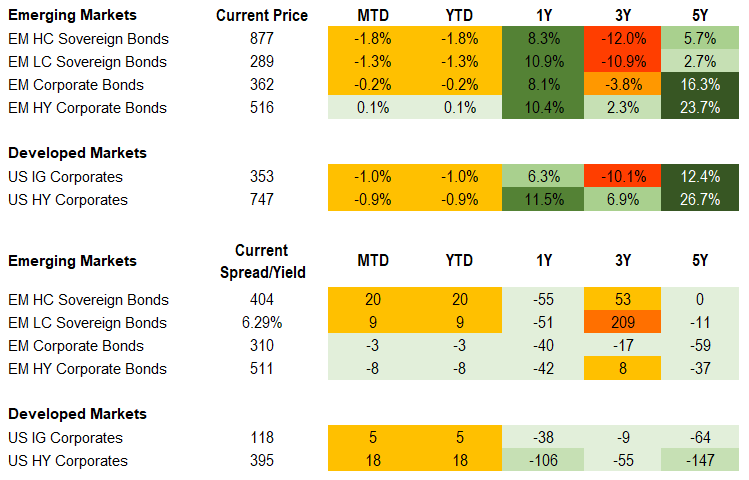
Equities
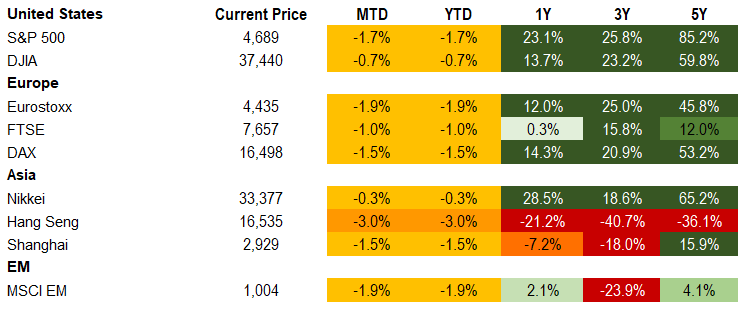
Commodities

Source for data tables: Bloomberg, JPMorgan, Gramercy. EM Fixed Income is represented by the following JPMorgan Indicies: EMBI Global, GBI-EM Global Diversified, CEMBI Broad Diversified and CEMBI Broad High Yield. DM Fixed Income is represented by the JPMorgan JULI Total Return Index and Domestic High Yield Index. Fixed Income, Equity and Commodity data is as of January 5, 2024 (mid-afternoon).
Emerging Markets Weekly Highlights
China December PMI data mixed on the back of renewed Pledged Supplemental Lending (PSL)
Event: NBS composite PMI remained lackluster at 50.3 while Caixin composite PMI increased by a point to 52.6 led by services strength. This follows the resumption of the PSL operation in December, a historically powerful policy tool, with the PBoC lending net RMB350bn to the policy banks after a cessation for 12 months.
Gramercy Commentary: The government likely achieved its 5% growth target for 2023. However, the still lackluster activity momentum, more limited base effects, and signals from last month’s Central Economic Work Conference, sets the stage for continuation of moderately supportive policy in 2024. The Central Bank will likely continue its use of PSL operations to support stable funding to policy banks throughout the year with a focus on public housing and urban village developments as well as relending facilities to aid in local debt resolutions. This, combined with rate cuts in a more muted global rate environment and expansionary fiscal policy, should help to drive growth this year.
Argentina submitted an ambitious reform bill to Congress and launched a program to address import debt
Event: Last week, the Milei Administration put forward a widespread bill which includes, but is not limited to, tax amendments and amnesty, suspension of the pension indexation formula, privatization of public companies, electoral reform, labor law adjustments, and declaration of a public emergency giving the President powers normally delegated to Congress. The bill also includes revenue measures previously outlined in Finance Minister Caputo’s 5% of GDP fiscal deficit reduction plan. Additionally, the Central Bank launched a new bond program, BOPREAL, aimed to address commercial debt of importers and reduce its renumerated liabilities.
Gramercy Commentary: The large and front-loaded fiscal reduction combined with widespread regulatory overhaul included in the omnibus bill and mega decree are largely constructive efforts to lay the groundwork for macroeconomic stabilization and recovery. While many aspects will face resistance in Congress, we think some pieces will pass. Importantly, the over 3% points of GDP in envisaged spending cuts do not require Congressional approval. Efforts to cleanup the Central Bank’s balance sheet and clear the import backlog are also positive, although initial auctions of the BOPREA27s received limited aggregate demand of just under $130mm.
Turkey inflation in line with expectations
Event: December inflation printed at 64.77% y/y (vs. Bloomberg consensus of 64.95%) up from 61.98% in November but down on a monthly basis to 2.93% from 3.28%. Core inflation continued to accelerate on durable goods, services, and rent.
Gramercy Commentary: We think that the data supports another 250bps hike from the Central Bank of the Republic of Turkey later this month, particularly in context of the 49% minimum wage hike that came into effect at the start of the year. This would bring the policy rate to 45%, helping to support a slower rate of TRY depreciation and normalization of the local curve later this quarter.
Emerging Markets Technicals
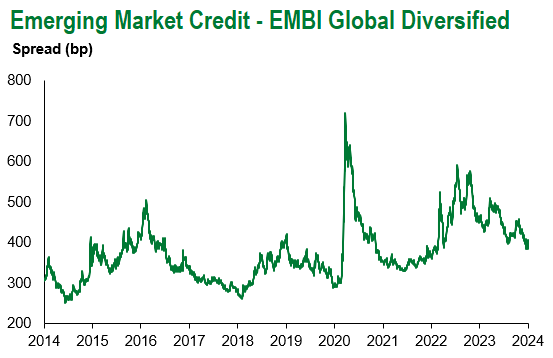
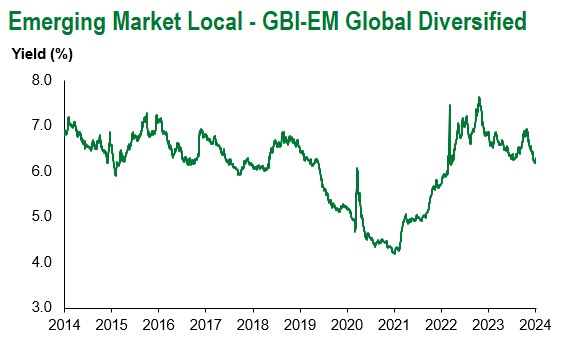
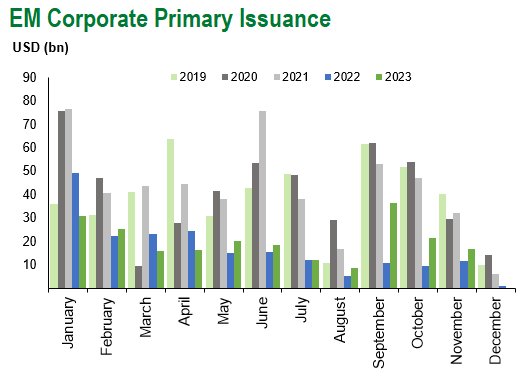
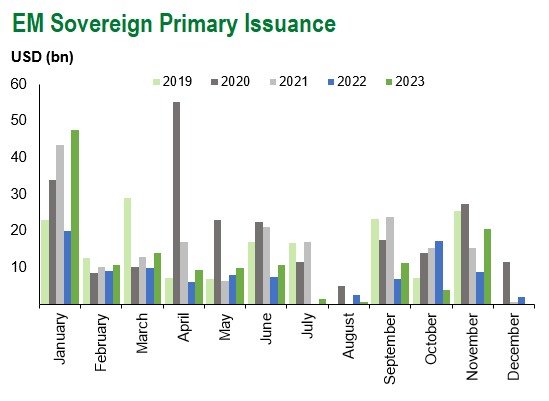
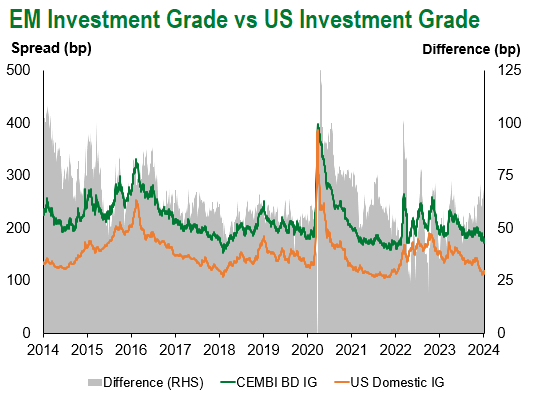
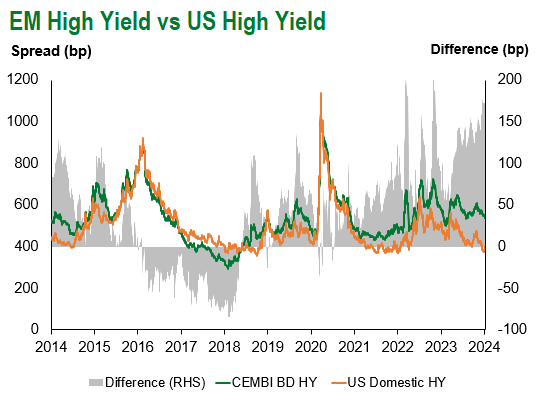
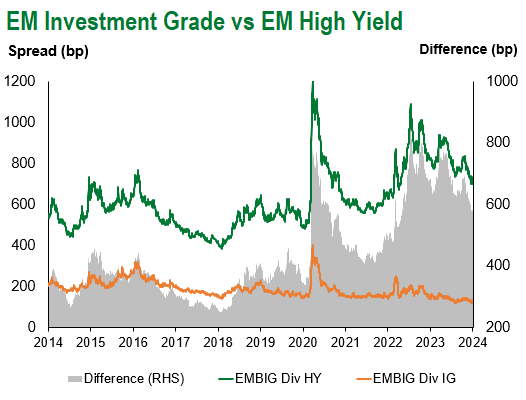
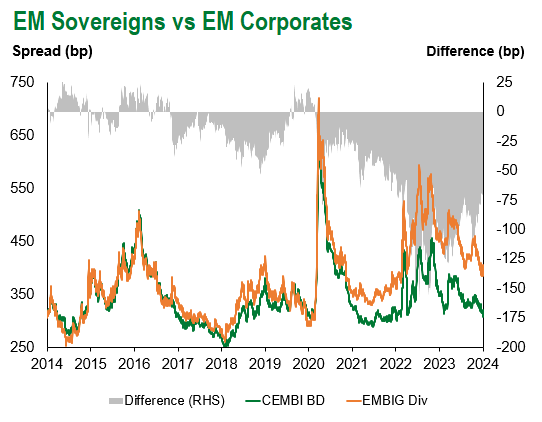
Emerging Markets Flows
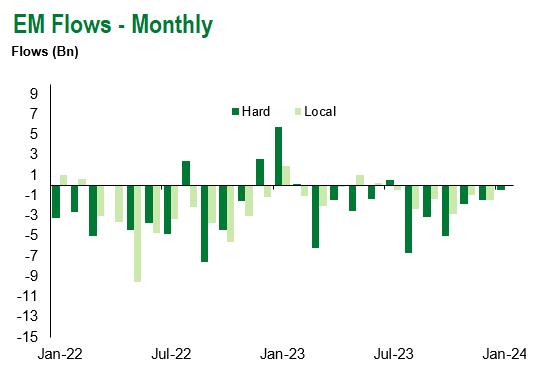
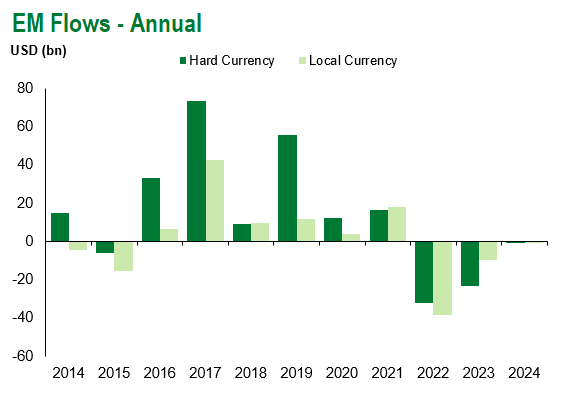
Source for graphs: Bloomberg, JPMorgan, Gramercy. As of January 5, 2024.
For questions, please contact:
Kathryn Exum, CFA ESG, Director, Co-Head of Sovereign Research, [email protected]
Petar Atanasov, Director, Co-Head of Sovereign Research, [email protected]
James Barry, Director, Deputy Portfolio Manager, [email protected]
This document is for informational purposes only. The information presented is not intended to be relied upon as a forecast, research or investment advice, and is not a recommendation, offer or solicitation to buy or sell any securities or to adopt any investment strategy. Gramercy may have current investment positions in the securities or sovereigns mentioned above. The information and opinions contained in this paper are as of the date of initial publication, derived from proprietary and nonproprietary sources deemed by Gramercy to be reliable, are not necessarily all-inclusive and are not guaranteed as to accuracy. This paper may contain “forward-looking” information that is not purely historical in nature. Such information may include, among other things, projections and forecasts. There is no guarantee that any forecasts made will come to pass. Reliance upon information in this paper is at the sole discretion of the reader. You should not rely on this presentation as the basis upon which to make an investment decision. Investment involves risk. There can be no assurance that investment objectives will be achieved. Investors must be prepared to bear the risk of a total loss of their investment. These risks are often heightened for investments in emerging/developing markets or smaller capital markets. International investing involves risks, including risks related to foreign currency, limited liquidity, less government regulation, and the possibility of substantial volatility due to adverse political, economic or other developments. References to any indices are for informational and general comparative purposes only. The performance data of various indices mentioned in this update are updated and released on a periodic basis before finalization. The performance data of various indices presented herein was current as of the date of the presentation. Please refer to data returns of the separate indices if you desire additional or updated information. Indices are unmanaged, and their performance results do not reflect the impact of fees, expenses, or taxes that may be incurred through an investment with Gramercy. Returns for indices assume dividend reinvestment. An investment cannot be made directly in an index. Accordingly, comparing results shown to those of such indices may be of limited use. The information provided herein is neither tax nor legal advice. Investors should speak to their tax professional for specific information regarding their tax situation.
